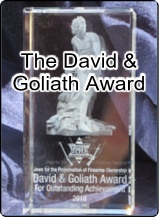

US V Olofson: A pseudolegal Case
By L.Neil Smith
For Jews for the Preservation of Firearms Ownership http://jpfo.org © 2007
![]()
The camera closes in.
The screen swells with the wizened, hateful visage, under its ludicrous English periwig, of George Jeffreys, the original "hanging judge" of the Bloody Assizes as he sentences the innocent Doctor Peter Blood, convicted of having treated a man wounded in a battle of the 1685 Monmouth Rebellion, to a lifetime of slavery in the British West Indies.
Nobody watching the 1935 movie "Captain Blood" was particularly surprised at the irrationality of the verdict or the harshness of the sentence. Judicial processes meant to bolster authority, often at the expense of justice and humanity, were a feature of the English court system, and one of many reasons -- as most individuals of my own and older generations were taught in school -- that Americans fought for independence.
Not so today. Now our children and our grandchildren are often told by a politically-corrected educational establishment that there was no good reason for the American Revolution, and that we'd all be better off if the colonials then had respected and cooperated with authority. As far as justice is concerned, they're told the humblest person, accused of a crime, can always count on getting "his day in court".
I'm sure that's just what young Kenyon Ballew, his family, and lawyers expected when they went to court seeking restitution because a violent gang of police and federal officers, for some reason disguised as hippies, smashed through his front door one summer evening in 1971 -- on a fraudulent plea-bargained tip from a newspaper boy they had arrested for burglary -- and shot at him more than a dozen times as he emerged naked from his bathtub, paralyzing him for the rest of his life.
The Ballew case may not have been the first instance of the new police "philosophy" of fascist thuggery, moronic incompetence, and brutal unconcern over "collateral damage" that has since flooded over this nation like a dirty tide, destroying whatever pretense was left that this is a free country, but it was the first many of us knew of, and nothing would ever be the same. A line of causality stretches taut and straight from Ballew's suburban Maryland home in 1971 to Mount Carmel on the rolling Texas plains in 1993 -- and continues on to this day.
All of this comes to mind because of a recent federal trial, the case of U.S. v. Olofson in Milwaukee Wisconsin, in which the Bureau of Alcohol, Tobacco, Firearms, and Explosives (instigators in both the Ballew and Branch Davidian atrocities) charged a National Guard Drill Instructor of "unlawful transfer of a machinegun" because, owing to a worn or broken part, it would sometimes -- very rarely, actually -- fire more than one round of ammunition with a single pull of the trigger.
This is not, in fact, any kind of illegal "enhancement", it is a dangerous malfunction. Len Savage, the expert I spoke with before I started this article tells me that when such a malfunction occurs, the particular weapon involved fires at three times the rate considered safe.
Olofson, it appears, was asked by a Robert Kiernicki to teach him to shoot. Olofson did, and even let Kiernicki take "his oldest AR-15" -- a semiautomatic version of our current military rifle the M-16 -- to a public range and practice. On Kiernicki's third time at the range, after firing 120 rounds, the rifle sputtered three times and jammed.
Law enforcement people present on the range swooped in, and in due course, Olofson was arrested, charged, and has now been convicted of a gun "crime" he never intended to commit or even knew he had committed, one that happened when he was miles away and someone else pulled the trigger.
The rifle in question was sent to the BATFE Firearm Technology Branch (FTB), who examined and test fired the weapon and declared it "just a rifle". Special Agent in Charge Jody Keeku asked FTB to re-test the firearm, this time using soft-primered commercial ammunition.
The FTB, which has no standardized testing procedures -- in fact, no written procedures at all for testing firearms -- tried again, this time getting the desired results. BATFE, with a self-admitted fifty percent error rate, then pursued an indictment against Olofson and paid Kiernicki "an undisclosed amount of money" to testify against him.
At the same time Olofson was being charged with unlawful transfer, because his rifle malfunctioned, and apparently had some M-16 parts (not the parts that would make it a machinegun) the BATFE removed another "machinegun" from its registry of such weapons because they deemed it to be an AR-15 with M-16 parts, but not a machinegun. Len can produce the documents to substantiate this extremely convenient contradiction.
Hear Len being interviewed on JPFO's podcast, Talkin' to America and see some of the legal documents associated with this case. Click on over to Talkin' to America (Jan 2008) and then proceed to the Olofson case links page.
Be aware, however the court never had access to this information. When Olofson's attorneys requested that the court compel BATFE to produce these and other documents proving Olofson's innocence, BATFE's Chief Counsel's Office loftily informed the court that the documents involved contained "tax information" -- namely, a $200 federal excise tax stamp -- and that the court was therefore prohibited from seeing them.
All such documents -- even a BATFE letter to the manufacturer of Olofson's rifle mandating a safety recall in 1986 (due to its going "full auto" if it malfunctioned) -- were kept secret from the judge in the case, Charles N. Clevert, and the rest of the court. BATFE's Chief Counsel told Assistant U.S. Attorney Gregory J. Haanstad, who passed it along: "The Court will have take our word that the documents in question contain tax information, and contain no exculpatory evidence".
Haanstad claimed the law does not exempt a malfunction. He claims that it states "any weapon that shoots more than once without manual reloading, per function of the trigger is a machinegun". When Len, acting as a defense expert, took the stand, he asked, "Are you saying if I take my great-granddaddy's double barrel shotgun out and pull one trigger, and both barrels go off, it's a machinegun?". Haanstad cited the law (U.S. Code, Section 5845[b]), restating that "any weapon that shoots ... "
If your semiauto rifle breaks, you are now subject to federal prosecution. Even more ironic, those in the sporting culture, who have derided so-called "black guns" and "assault rifles" for so long, now face a real possibility of their expensive double shotguns being seized, and of possible prosecution, if BATFE's no-standards laboratory -- which has no procedures in writing and does all of its testing in secret -- can make it fire more than once with a single pull of the trigger. If there is information proving their innocence, BATFE can always claim it's tax information, and prevent both judge and jury from considering it.
Len and I differ on one central point in this mess, gun expert though he is. He is a tough, decent, bright, and courageous gentleman, and I have no desire at all to argue with him in public. He believes that the judge in this case conducted himself properly and points out that the man even chastized the federal prosecutors on at least one occasion because they had attempted to deceive him and the defense attorneys.
This is not a new thing. At one of the legal proceedings against Kenyon Ballew, back in the 70s, the prosecution brought in "evidence" of Ballew's "criminality" consisting of a can of black pistol powder which they claimed he was going to use to make grenades. In fact, he used it to load his only handgun, a replica of an 1847 Colt Walker revolver.
But it wasn't enough simply to produce the can. They brought in at the center of a long, long plank, its ends supported by a pair of theatrically nervous individuals acting as though what it held was nitroglycerin.
BATFE's conduct at the Olofson trial was subtler, but just as criminally misleading. What the judge should have said is, "You will tell your agency to produce those documents immediately, or I will have you locked up until they do. Bailiff!" The fact that he didn't say that makes him a bad judge, a weak judge, and anticonstitutional judge.
BATFE's very existence is a violation of the highest law of the land, in and of itself. How can this sort of stupendously outrageous crime go on for decade after decade? Answer: who signs a judge's paycheck?
BATFE drifts, utterly rudderless, without underlying principles, precisely like the entire United States government does today. The criminally totalitarian mind-set that permitted the creation of this agency in the first place -- despite the clear language of the Bill of Rights -- encourages wars to be waged without any legal declaration by Congress, and kidnapping and torture to become working policies of what was once supposed to be the freest country on the face of the Earth.
It does so because it suits those who profit, in terms of power and privilege or other ill-gotten gains, from such a moral and legal vacuum.
![]()
Four-time Prometheus Award-winner L. Neil Smith has been writing about guns and gun ownership for more than 30 years. He is the author of 27 books, the most widely-published and prolific libertarian novelist in the world, and is considered an expert on the ethics of self-defense. His writings may be seen on the following sites:
The Webley Page.
The Libertarian Enterprise.
LNS at Random (blog).
(Find other articles by L.Neil Smith)
![]()
























